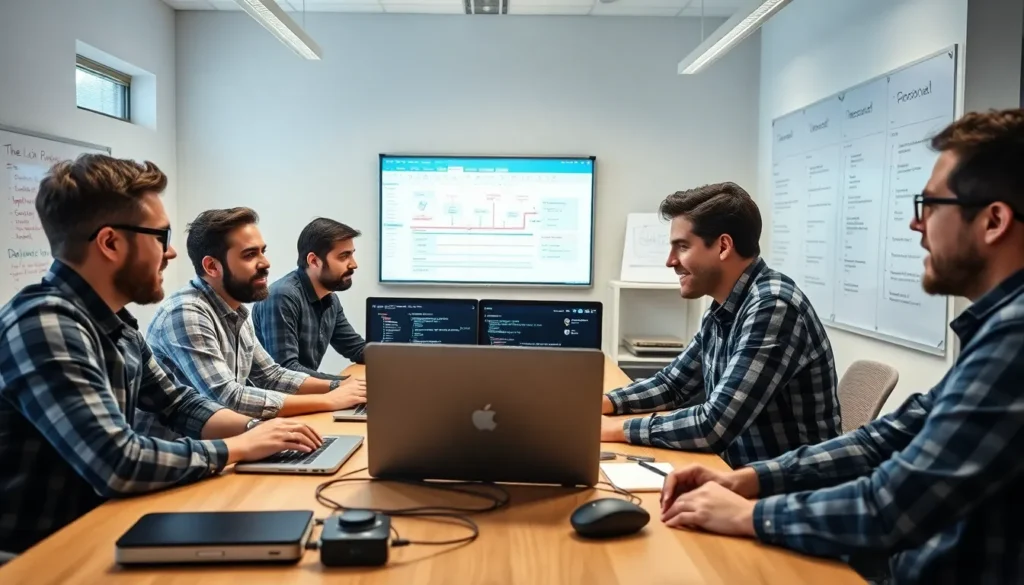In the fast-paced world of software development, CI/CD pipelines are the unsung heroes, tirelessly working behind the scenes to deliver updates faster than a cat meme can go viral. But just like that trusty coffee machine that occasionally needs a tune-up, these pipelines can benefit from a little love and improvement. Why settle for a mediocre pipeline when you can supercharge it and watch your deployment times shrink like your favorite pair of jeans after a wash?
Table of Contents
ToggleUnderstanding CI/CD Pipelines
CI/CD pipelines streamline the software development process, enabling teams to deliver updates more frequently and reliably. Improving these pipelines plays a crucial role in enhancing overall productivity and quality.
Definition and Importance
Continuous Integration (CI) involves regularly integrating code changes into a shared repository. Automating this process helps identify bugs earlier, reducing integration issues. Continuous Deployment (CD) follows, ensuring every change passes automated tests and reaches users quickly. Effective CI/CD pipelines increase collaboration among teams and improve software quality, contributing to faster time-to-market. As a result, organizations benefit from meeting user expectations consistently.
Key Components of CI/CD
Several key components form the foundation of CI/CD pipelines. Version control systems manage code changes and support collaboration. Automated testing frameworks ensure that updates function as intended without introducing new issues. Build servers automate the process of compiling and packaging software, making releases smoother. Monitoring tools track application performance post-deployment, identifying any problems that require immediate attention. Together, these components create a cohesive environment, allowing for responsive and efficient software development.
Common Challenges in CI/CD Pipelines

CI/CD pipelines often face several obstacles that hinder their effectiveness. Identifying these challenges is crucial for implementing improvements.
Manual Processes
Manual processes slow down the entire CI/CD workflow. Frequent manual intervention increases the risk of human error, which may lead to issues in testing and deployment. Automating repetitive tasks eliminates bottlenecks and enables teams to focus on higher-value activities. For instance, introducing automated testing tools minimizes the chances of bugs reaching production. Deploying continuous integration practices helps streamline these manual steps, allowing for faster feedback cycles. Reducing reliance on manual processes creates a robust framework for development and deployment.
Integration Issues
Integration issues commonly arise when different teams work simultaneously on various code branches. Conflicts during merge requests can lead to delays and complicate the release process. Frequent integration helps uncover problems early, but incomplete synchronization can hinder this effort. Coordinating between diverse tools and platforms also complicates seamless integration. To address this, employing standardized integration practices aligns team efforts and reduces conflicts. Implementing clear guidelines for code contributions further enhances collaboration and decreases integration-related disruptions.
Strategies for CI/CD Pipeline Improvements
Improving CI/CD pipelines requires a set of effective strategies. Implementation of these techniques can streamline processes, boost efficiency, and enhance overall software quality.
Automation Techniques
Implementing automation techniques significantly boosts CI/CD efficiency. Continuous testing tools eliminate manual testing, saving time and reducing errors. Automated deployment scripts ensure that code changes move seamlessly from development to production, minimizing human intervention. Additionally, utilizing infrastructure as code simplifies environment setup, ensuring consistency across deployments. Emphasizing automation across various stages of the pipeline fosters rapid feedback and enhances collaboration among teams.
Monitoring and Feedback Loops
Establishing robust monitoring and feedback loops enhances CI/CD responsiveness. Continuous monitoring of application performance provides immediate insights into issues post-deployment, allowing for quick resolutions. Integration of automated alerts for failure conditions helps teams address problems proactively. Through the creation of feedback mechanisms, such as user metrics and team retrospectives, organizations can continuously learn and adapt their pipelines. Prioritizing these loops facilitates ongoing improvements, fostering an environment of constant enhancement.
Tools and Technologies for Enhancement
Improving CI/CD pipelines requires leveraging modern tools and technologies for optimal performance. Several popular solutions stand out for their efficacy in streamlining development processes.
Popular CI/CD Tools
Jenkins serves as a leading automation server, offering a range of plugins to support building, deploying, and automating projects. GitLab CI/CD integrates seamlessly with version control environments, enabling efficient code review and deployment processes. CircleCI emphasizes rapid performance, allowing for quick configuration of builds and deployments. Travis CI stands out with its ease of use, particularly for open-source projects. Azure DevOps provides comprehensive tools for managing development projects, including CI/CD capabilities that support both cloud and on-premises deployments. These tools help enhance collaboration, reduce errors, and accelerate delivery cycles.
Integrating New Technologies
Integrating new technologies into CI/CD pipelines enhances functionality and efficiency. Utilizing Docker for containerization simplifies deployment processes by ensuring consistency across different environments. Kubernetes automates container orchestration, enabling seamless scaling and management of applications. Adopting serverless architecture can reduce infrastructure overhead, allowing teams to focus on core functionality. Additionally, incorporating AI for predictive analytics improves decision-making and error detection during testing phases. Adapting to these technologies fosters a culture of innovation and responsiveness in the software development lifecycle.
Best Practices for Successful Implementation
Effective implementation of CI/CD pipelines relies on several best practices. Prioritizing these practices enhances overall efficiency and collaboration across teams.
Ensuring Team Collaboration
Fostering an environment that encourages collaboration is essential for successful CI/CD implementation. Clear communication among team members minimizes misunderstandings and aligns goals. Regular meetings help in identifying challenges early on, promoting proactive problem-solving. Equally important, implementing standardized processes facilitates consistency in code contributions. Tools like Jira or Confluence can enhance visibility of project statuses, allowing for timely adjustments. When team members collaborate effectively, they significantly reduce integration issues, resulting in smoother deployment cycles.
Continuous Learning and Adaptation
Promoting a culture of continuous learning benefits CI/CD pipelines immensely. Teams should regularly review their processes to identify areas for improvement. Leveraging feedback from automated tests and deployment results drives informed decision-making. Additionally, incorporating industry best practices keeps the team updated on innovative techniques. Training sessions or workshops can deepen skills and enhance team adaptability. When teams embrace a mindset geared toward evolution, they not only improve efficiency but also ensure that the pipeline adapts to changing project needs.
Improving CI/CD pipelines is essential for any software development team aiming to enhance efficiency and quality. By embracing automation and integrating advanced tools, teams can streamline their processes and reduce the risk of errors.
Fostering collaboration and maintaining open communication further contribute to smoother workflows and quicker deployments. Continuous learning and adaptation to new technologies ensure that teams remain agile and responsive to user needs.
Ultimately, prioritizing these improvements not only accelerates delivery but also aligns development efforts with business goals, paving the way for long-term success in the ever-evolving tech landscape.






